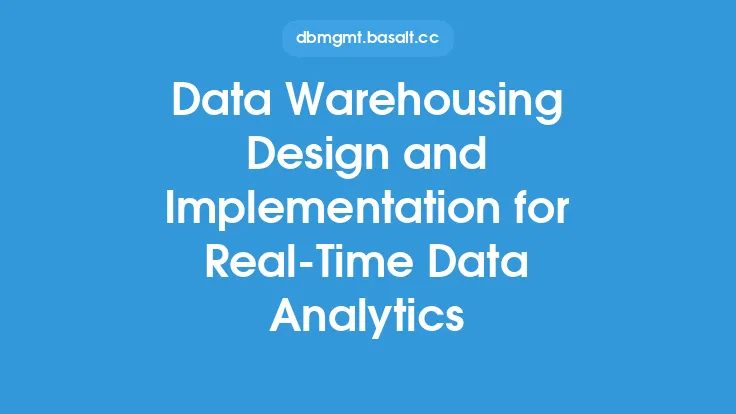When it comes to data warehousing, data modeling plays a crucial role in ensuring that the data is properly organized, easily accessible, and provides valuable insights to the business. Data modeling for data warehousing involves creating a conceptual representation of the data, including the relationships between different entities, to support business intelligence and analytics. In this article, we will delve into the key considerations for data modeling in a data warehousing context, exploring the fundamental principles, best practices, and technical aspects that are essential for a successful data warehousing project.
Introduction to Data Modeling for Data Warehousing
Data modeling for data warehousing is a process that involves creating a data model that is optimized for querying and analysis. This requires a deep understanding of the business requirements, the data sources, and the data itself. A good data model should be able to support the business intelligence and analytics needs of the organization, while also ensuring that the data is properly organized and easily accessible. The data model should be designed to handle large volumes of data, support complex queries, and provide fast query performance.
Key Considerations for Data Modeling
There are several key considerations that need to be taken into account when creating a data model for a data warehouse. These include:
- Data granularity: The level of detail at which the data is stored. A higher level of granularity allows for more detailed analysis, but can also increase the complexity of the data model.
- Data normalization: The process of organizing the data to minimize data redundancy and improve data integrity. Normalization is essential for ensuring that the data is consistent and accurate.
- Data denormalization: The process of intentionally denormalizing the data to improve query performance. Denormalization can be used to pre-aggregate data, reduce joins, and improve query performance.
- Data relationships: The relationships between different entities in the data model. These relationships can be used to create a robust and scalable data model.
- Data governance: The process of managing the data to ensure that it is accurate, complete, and secure. Data governance is essential for ensuring that the data is trustworthy and reliable.
Data Modeling Techniques
There are several data modeling techniques that can be used to create a robust and scalable data model. These include:
- Entity-relationship modeling: A technique that involves creating a conceptual representation of the data, including the relationships between different entities.
- Dimensional modeling: A technique that involves creating a data model that is optimized for querying and analysis. Dimensional modeling is particularly useful for data warehousing, as it allows for fast query performance and supports complex queries.
- Object-relational modeling: A technique that involves creating a data model that combines the benefits of object-oriented and relational modeling.
Data Warehouse Schema Design
The data warehouse schema design is a critical aspect of data modeling for data warehousing. The schema design should be optimized for querying and analysis, and should support the business intelligence and analytics needs of the organization. There are several schema design options available, including:
- Star schema: A schema design that involves creating a central fact table surrounded by dimension tables. Star schema is particularly useful for data warehousing, as it allows for fast query performance and supports complex queries.
- Snowflake schema: A schema design that involves creating a central fact table surrounded by dimension tables, with each dimension table further divided into sub-dimension tables. Snowflake schema is more complex than star schema, but can provide additional benefits in terms of data granularity and query performance.
- Galaxy schema: A schema design that involves creating multiple fact tables, each with its own set of dimension tables. Galaxy schema is particularly useful for large and complex data warehouses, as it allows for greater flexibility and scalability.
Data Modeling Tools and Technologies
There are several data modeling tools and technologies available that can be used to create and manage a data model. These include:
- Data modeling software: Such as ER/Studio, PowerDesigner, and Enterprise Architect.
- Database management systems: Such as Oracle, Microsoft SQL Server, and IBM DB2.
- Data warehousing platforms: Such as Amazon Redshift, Google BigQuery, and Microsoft Azure Synapse Analytics.
- Data governance tools: Such as Collibra, Informatica, and Talend.
Best Practices for Data Modeling
There are several best practices that should be followed when creating a data model for a data warehouse. These include:
- Keep it simple: Avoid complex data models that are difficult to understand and maintain.
- Use standard naming conventions: Use standard naming conventions to ensure that the data model is consistent and easy to understand.
- Use data governance: Use data governance to ensure that the data is accurate, complete, and secure.
- Test and validate: Test and validate the data model to ensure that it meets the business intelligence and analytics needs of the organization.
- Document and maintain: Document and maintain the data model to ensure that it remains up-to-date and relevant.
Conclusion
Data modeling for data warehousing is a critical aspect of creating a successful data warehousing project. By following the key considerations, using the right data modeling techniques, and following best practices, organizations can create a robust and scalable data model that supports their business intelligence and analytics needs. Whether you are using a star schema, snowflake schema, or galaxy schema, the key is to create a data model that is optimized for querying and analysis, and that provides fast query performance and supports complex queries. By using the right data modeling tools and technologies, and following best practices, organizations can ensure that their data warehouse is properly organized, easily accessible, and provides valuable insights to the business.





